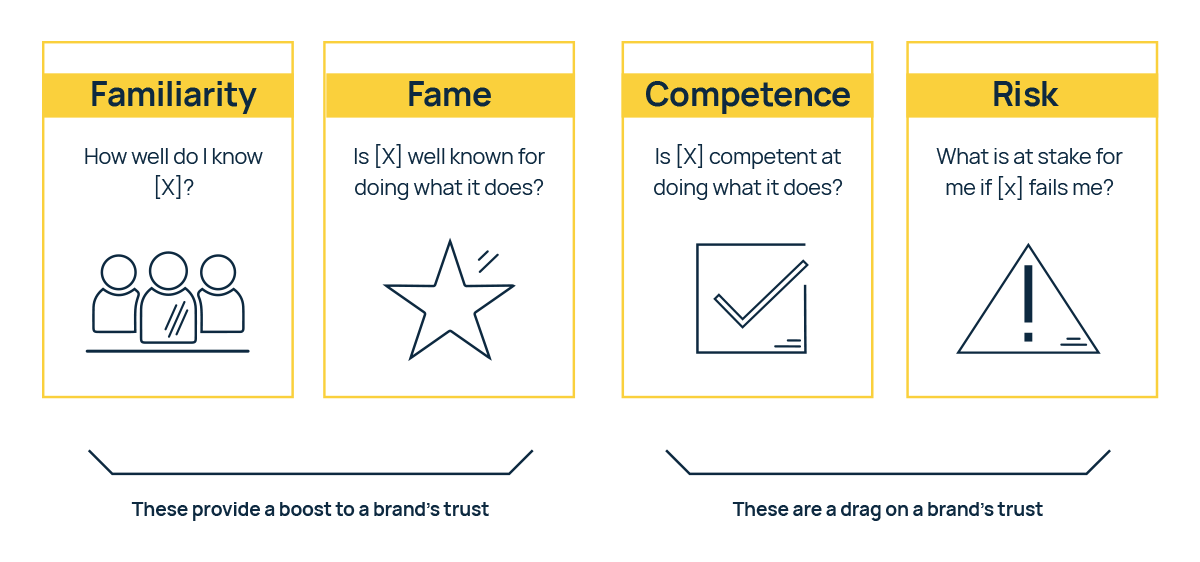On the back of our latest trust research, Newsworks has designed a trust calculator to help provide agencies and advertisers with a more accurate measurement of the overall trust in their brand. This will act as a diagnostic tool to help identify areas to focus on in the future to increase levels of trust.
Please use the boxes below for more information on how to use the trust calculator. You can read the full report here.
*We recommend using this calculator on your desktop for the best experience.
Below are the four questions you’ll need to ask about a brand to calculate their trust score. This should be asked of a nationally representative online sample. The percentages from these are needed to input into our trust calculator.
Familiarity
How familiar are you personally with [INPUT BRAND NAME]?
- Very familiar
- Somewhat familiar
- Not very familiar
- Not at all familiar
Fame
How well known would you say [INPUT BRAND NAME] is?
- Very well-known
- Somewhat well-known
- Not very well-known
- Not at all well-known
Competence
Would you describe [INPUT BRAND NAME] as…
- Very competent, excellent at what they do
- Competent, good at what they do
- I don’t know enough about it
- Not that competent or good at what they do
- Incompetent, terrible at what they do
Risk
How much of a potential risk would you say you are taking when using [INPUT BRAND NAME]?
The risk could be related to the reliability and service provided or could be financial, safety-related or just the inconvenience if something were to go wrong.
- A small risk
- No risk at all
- I don’t know enough about it
- A moderate risk
- A big risk
Once you have the results for the four survey questions, you will need to input the percentage of people that selected the top two options for fame and familiarity and the bottom two options for competence and risk. See below:
- Familiarity = very familiar or somewhat familiar
- Fame = very well-known or somewhat well-known
- Incompetence = incompetent, terrible at what they do or not that competent or good at what it does
- Risk = a big risk or a moderate risk
You’ll be able to see the brand’s composite trust score and how it compares to the average – based on 150 brands that we tested in our research study. You can use the results to assess areas where a brand can improve on its trust score – remembering you want the lowest score possible for competency and risk and highest score for fame and familiarity.
Our research showed that there are four pillars that make up trust. By measuring each of these both individually and combined, brands are better equipped to understand not only how trusted they are but what is holding trust back.
The four pillars of trust split into two groups. One group measures the fame & familiarity of a brand – these provide a boost to brand trust. The second measures the risk or perceived competence of a brand – these hold trust back.
By evaluating a brand against all four of these pillars we are able to calculate an overall composite trust score out of 10.
1. Familiarity – How well do I know the brand? Because trust is accrued and built up over time, through repeated interactions, the more experience we have, the more confident we can be to trust.
2. Fame – Is the brand known to be competent? Do others regard them as such? This considers the cognitive bias of social proof. We draw our cues about whether to trust from others.
3. Competence – Is the brand considered good or bad at doing what it does? To ask if we trust someone (or something) is to ask what we are trusting them to do.
4. Risk – What is the general perception of risk in a category (and a brand) and what is at stake? The higher the perceived risk – financial, social, safety – of getting it wrong, the more trust matters.

